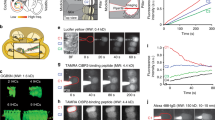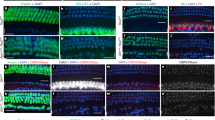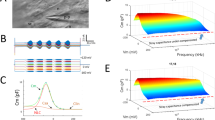Abstract
Excitable cells use ion channels to tailor their biophysical properties to the functional demands made upon them1. During development, these demands may alter considerably, often associated with a change in the cells' complement of ion channels2,3,4. Here we present evidence for such a change in inner hair cells, the primary sensory receptors in the mammalian cochlea. In mice, responses to sound can first be recorded from the auditory nerve and observed behaviourally from 10–12 days after birth; these responses mature rapidly over the next 4 days5,6,7,8. Before this time, mouse inner hair cells have slow voltage responses and fire spontaneous and evoked action potentials. During development of auditory responsiveness a large, fast potassium conductance is expressed, greatly speeding up the membrane time constant and preventing action potentials. This change in potassium channel expression turns the inner hair cell from a regenerative, spiking pacemaker into a high-frequency signal transducer.
This is a preview of subscription content, access via your institution
Access options
Subscribe to this journal
Receive 51 print issues and online access
$199.00 per year
only $3.90 per issue
Buy this article
- Purchase on Springer Link
- Instant access to full article PDF
Prices may be subject to local taxes which are calculated during checkout



Similar content being viewed by others
References
Hille, B. Ionic Channels of Excitable Membranes2nd edn (Sinauer, Sunderland, MA, (1992)).
O'Dowd, D. L., Ribera, A. B. & Spitzer, N. C. Development of voltage-dependent calcium, sodium and potassium currents in Xenopus spinal neurons. J. Neurosci. 8, 792–805 (1988).
Fuchs, P. A. & Sokolowski, B. H. A. The acquisition during development of Ca-activated potassium currents by cochlear hair cells of the chick. Proc. R. Soc. Lond. B 241, 122–126 (1990).
Spitzer, N. C. Adevelopmental handshake: neuronal control of ionic currents and their control of neuronal differentiation. J. Neurobiol. 22, 659–673 (1991).
Mikaelian, D. & Ruben, R. J. Development of hearing in the normal CBA-J mouse. Acta Otolaryngol. 59, 451–461 (1965).
Shnerson, A. & Pujol, R. Age-related changes in the C57BL/6J mouse cochlea. I. Physiological findings. Dev. Brain Res. 2, 65–75 (1982).
Romand, R. in Development of Auditory and Vestibular Systems(ed. Romand, R.) 47–88 (Academic, New York, (1983)).
Ehret, G. in Development of Auditory and Vestibular Systems(ed. Romand, R.) 211–237 (Academic, New York, (1983)).
Pujol, R., Lavigne-Rebillard, M. & Lenoir, M. in Development of the Auditory System(eds Rubel, E. W., Popper, A. N. & Fay, R. R.) 146–192 (Springer, New York, (1998)).
Walsh, E. J. & Romand, R. in Development of Auditory and Vestibular Systems 2(ed. Romand, R.) 161–219 (Elsevier Science, New York, (1992)).
Rübsamen, R. & Lippe, W. R. in Development of the Auditory System(eds Rubel, W. W., Popper, A. N. & Fay, R. R.) 193–270 (Springer, New York, (1998)).
Appenrodt, P. & Kros, C. J. Single-channel recordings of large-conductance Ca2+-activated K+ channels from guinea-pig inner hair cells. J. Physiol. 501, 147P(1997).
Kirkwood, N. K. & Kros, C. J. Rapid photorelease of calcium augments the fast potassium conductance of guinea-pig inner hair cells. J. Physiol. 504, 127P ((1997)).
Kros, C. J. & Crawford, A. C. Potassium currents in inner hair cells isolated from the guinea-pig cochlea. J. Physiol. 421, 263–291 (1990).
Kros, C. J. in The Cochlea(eds Dallos, P., Popper, A. N. & Fay, R. R.) 318–385 (Springer, New York, (1996)).
Kaczorowski, G. J., Knaus, H.-G., Leonard, R. J., McManus, O. B. & Garcia, M. L. High-conductance calcium-activated potassium channels; structure, pharmacology, and function. J. Bioenerg. Biomembr. 28, 255–267 (1996).
Mu, M. Y., Chardin, S., Avan, P. & Romand, R. Ontogenesis of rat cochlea. A quantitative study of the organ of Corti. Dev. Brain Res. 99, 29–37 (1997).
Kros, C. J., Rüsch, A., Richardson, G. P. & Russell, I. J. Sodium and calcium currents in cultured cochlear hair cells of neonatal mice. J. Physiol. 473, 231P(1993).
Hudspeth, A. J. & Corey, D. P. Sensitivity, polarity, and conductance change in the response of vertebrate hair cells to controlled mechanical stimuli. Proc. Natl Acad. Sci. USA 74, 2407–2411 (1977).
Art, J. J. & Fettiplace, R. Variation of membrane properties in hair cells isolated from the turtle cochlea. J. Physiol. 385, 207–242 (1987).
Evans, M. G. & Fuchs, P. A. Tetrodotoxin-sensitive, voltage-dependent sodium currents in hair cells from the alligator cochlea. Biophys. J. 52, 649–652 (1987).
Fuchs, P. A., Nagai, T. & Evans, M. G. Electrical tuning in hair cells isolated from the chick cochlea. J.Neurosci. 8, 2460–2467 (1988).
Sugihara, I. & Furukawa, T. Morphological and functional aspects of two different types of hair cells in the goldfish sacculus. J. Neurophysiol. 62, 1330–1343 (1989).
Lippe, W. R. Rhythmic spontaneous activity in the developing avian auditory system. J. Neurosci. 14, 1486–1495 (1994).
Gummer, A. W. & Mark, R. F. Patterned neural activity in brain stem auditory areas of a prehearing mammal, the tammar wallaby (Macropus eugenii). NeuroReport 5, 685–688 (1994).
Géléoc, G. S. G., Lennan, G. W. T., Richardson, G. P. & Kros, C. J. Aquantitative comparison of mechanoelectrical transduction in vestibular and auditory hair cells of neonatal mice. Proc. R. Soc. Lond. B 264, 611–621 (1997).
Palmer, A. R. & Russell, I. J. Phase-locking in the cochlear nerve of the guinea-pig and its relation to the receptor potential of inner hair cells. Hear. Res. 24, 1–15 (1986).
Kettner, R. E., Feng, J.-Z. & Brugge, J. F. Postnatal development of the phase-locked response to low frequency tones of auditory nerve fibres in the cat. J. Neurosci. 5, 275–283 (1985).
Russell, I. J. & Richardson, G. P. The morphology and physiology of hair cells in organotypic cultures of the mouse cochlea. Hear. Res. 31, 9–24 (1987).
Acknowledgements
This work was begun at the University of Sussex and was supported by MRC programme grants to I. J. Russell, G. P. Richardson and C.J.K., and a DFG postdoctoral grant to A.R. We thank R. A. Eatock for providing facilities for additional experiments at Baylor College of Medicine, and E.Glowatzki, M. C. Holley, G. P. Richardson and I. J. Russell for commenting on an early version of the manuscript. C.J.K. is a Royal Society University Research Fellow.
Author information
Authors and Affiliations
Corresponding author
Supplementary information
Supplementary Information 1
Table of all cells contributing to Figure 2. (DOC 35 kb)
Supplementary Information 2a
Acutely isolated organ of Corti of a P18 mouse (basal coil, 540-720 degrees from helicotrema). (GIF 286 kb)
Supplementary Information 2b
Acutely isolated organ of Corti of a P18 mouse (basal coil, 540-720 degrees from helicotrema). (TXT 0 kb)
Supplementary Information
Supplementary Information (PDF 547 kb)
Rights and permissions
About this article
Cite this article
Kros, C., Ruppersberg, J. & Rüsch, A. Expression of a potassium current in inner hair cells during development of hearing in mice. Nature 394, 281–284 (1998). https://doi.org/10.1038/28401
Received:
Accepted:
Issue Date:
DOI: https://doi.org/10.1038/28401
This article is cited by
-
Central auditory deficits associated with genetic forms of peripheral deafness
Human Genetics (2022)
-
Purinergic Modulation of Activity in the Developing Auditory Pathway
Neuroscience Bulletin (2020)
-
Label-free quantitative mass spectrometry analysis of differential protein expression in the developing cochlear sensory epithelium
Proteome Science (2018)
-
Mechanotransduction is required for establishing and maintaining mature inner hair cells and regulating efferent innervation
Nature Communications (2018)
-
ON-OFF receptive fields in auditory cortex diverge during development and contribute to directional sweep selectivity
Nature Communications (2018)
Comments
By submitting a comment you agree to abide by our Terms and Community Guidelines. If you find something abusive or that does not comply with our terms or guidelines please flag it as inappropriate.



